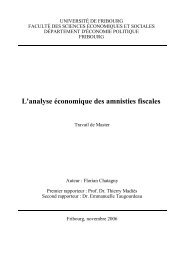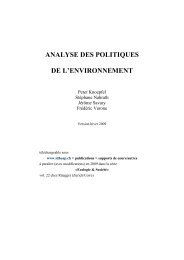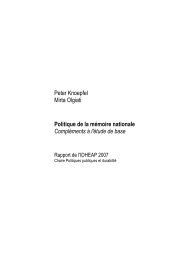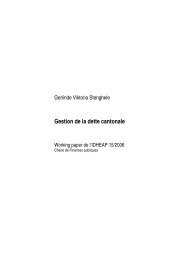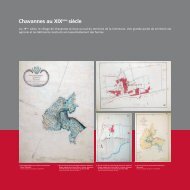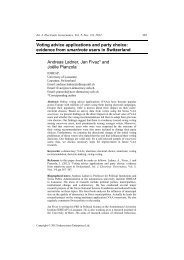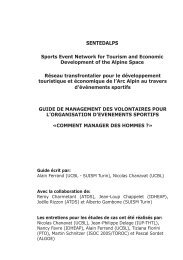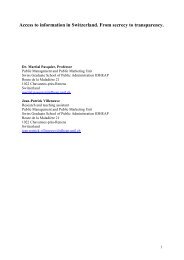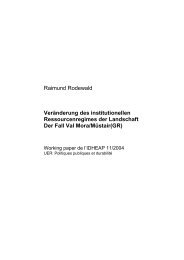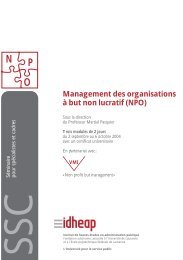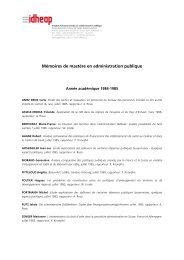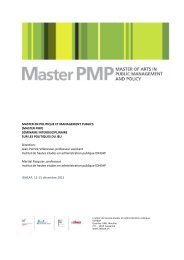Historical Analysis of Institutional Regimes in Switzerland ... - IDHEAP
Historical Analysis of Institutional Regimes in Switzerland ... - IDHEAP
Historical Analysis of Institutional Regimes in Switzerland ... - IDHEAP
Create successful ePaper yourself
Turn your PDF publications into a flip-book with our unique Google optimized e-Paper software.
14<br />
Private property rights (<strong>in</strong>dependent <strong>of</strong> the basic ownership situation) appear to be emerg<strong>in</strong>g (bought<br />
by means <strong>of</strong> visitors' taxes at health resorts/spas, access fees etc.). There is also a movement <strong>in</strong> the<br />
direction <strong>of</strong> state or even world property rights (UNESCO) to landscapes composed <strong>of</strong> plots which<br />
are privately owned. New forms or bodies for landscape ma<strong>in</strong>tenance are emerg<strong>in</strong>g <strong>in</strong> areas <strong>of</strong><br />
significant ecological value which lack management. Ma<strong>in</strong>tenance could be assured through the selforganisation<br />
<strong>of</strong> non-owners.<br />
Policy Design: The creation <strong>of</strong> a Swiss national park <strong>in</strong> the early 20th century can be identified as the<br />
precursor <strong>of</strong> nature conservation policy. The first protective measures were private <strong>in</strong> nature. The<br />
f<strong>in</strong>ancial <strong>in</strong>volvement <strong>of</strong> the Swiss Federation was regulated as early as 1914. The land still belonged<br />
to the local authorities, however, the national park area was regulated by means <strong>of</strong> contracts<br />
between the owners and the public-law foundation “Schweizerischer Nationalpark” [“Swiss National<br />
Park”]. A national park is a nature reserve <strong>in</strong> which nature is protected aga<strong>in</strong>st all human <strong>in</strong>tervention.<br />
Landscape protection really came <strong>in</strong>to be<strong>in</strong>g <strong>in</strong> <strong>Switzerland</strong> with the <strong>in</strong>clusion <strong>of</strong> nature and habitat<br />
conservation <strong>in</strong> the federal constitution which was further concretised <strong>in</strong> the Federal Law on the<br />
Conservation <strong>of</strong> Nature and Habitats <strong>of</strong> 1967 (NHG). The protection <strong>of</strong> nature and habitats is,<br />
however, the responsibility <strong>of</strong> the cantons. The state assumed a subsidiary function and was only to<br />
be <strong>in</strong>volved when cantonal efforts fail to achieve the desired aims. It also had sole authorisation to<br />
enact provisions <strong>in</strong> the areas <strong>of</strong> fauna and flora. In this first phase <strong>of</strong> nature conservation, the ma<strong>in</strong><br />
priority was to protect <strong>Switzerland</strong>’s valuable natural and cultural heritage. Implementation <strong>of</strong> the<br />
1967 act was very gradual, a fact which can probably be expla<strong>in</strong>ed by the selected mix <strong>of</strong><br />
<strong>in</strong>struments. The NHG conta<strong>in</strong>s provisions for the record<strong>in</strong>g <strong>of</strong> objects worthy <strong>of</strong> conservation <strong>in</strong><br />
national <strong>in</strong>ventories. However, the concentrated protection <strong>of</strong> objects conta<strong>in</strong>ed <strong>in</strong> the <strong>in</strong>ventory is<br />
not absolute. If this is opposed by <strong>in</strong>tervention <strong>in</strong>terests <strong>of</strong> national importance, it is possible to<br />
override this provision, however, the decision-mak<strong>in</strong>g <strong>in</strong>stance must obta<strong>in</strong> a report from the relevant<br />
and <strong>in</strong>dependent commission (Eidgenössische Natur- und Heimatschutzkommission) [Swiss<br />
Commission for Nature and Habitat Conservation). (Leimbacher/Perler 2000: 183ff) The state can,<br />
moreover, provide support for nature and habitat conservation <strong>in</strong> the form <strong>of</strong> f<strong>in</strong>ancial <strong>in</strong>struments,<br />
guarantee it by means <strong>of</strong> contracts or acquire them by means <strong>of</strong> expropriation.<br />
This conservation-based philosophy changed dur<strong>in</strong>g the 1970s as a result <strong>of</strong> the <strong>in</strong>fluence <strong>of</strong> ideas<br />
from regional development. The Federal Law on Regional Development marked an important<br />
departure for the preservation <strong>of</strong> the landscape <strong>in</strong> that it <strong>in</strong>troduced the dist<strong>in</strong>ction between settlement<br />
and non-settlement areas. The “orderly settlement <strong>of</strong> land” <strong>in</strong>troduced <strong>in</strong> the regional development<br />
legislation def<strong>in</strong>ed how land should be used. The plann<strong>in</strong>g <strong>of</strong> protective zone <strong>in</strong> accordance with this<br />
legislation became an important <strong>in</strong>strument for landscape protection. In the 1970s, urgent state<br />
measures forced the cantons to classify as temporary conservation areas, areas <strong>in</strong> which construction<br />
was to be restricted for reasons <strong>of</strong> landscape protection, to ensure the preservation <strong>of</strong> sufficient<br />
leisure amenities and protection aga<strong>in</strong>st the elements.<br />
This concept <strong>of</strong> protection was further expanded <strong>in</strong> the 1980s. The protection and viability <strong>of</strong><br />
ecosystems and the natural balance assumed <strong>in</strong>creas<strong>in</strong>g significance. This “paradigm change” can be<br />
expla<strong>in</strong>ed <strong>in</strong> terms <strong>of</strong> the environmental protection legislation and the <strong>in</strong>troduction <strong>of</strong> moor protection<br />
as well as ecological compensation payments. Initial approaches for the protection/conservation <strong>of</strong><br />
liv<strong>in</strong>g space or habitats can be found <strong>in</strong> Article 18 Paragraph 1 <strong>of</strong> the Federal Law on the<br />
Conservation <strong>of</strong> Nature and Habitats, whereby fauna and flora were to be protected from ext<strong>in</strong>ction<br />
through the preservation <strong>of</strong> sufficiently large habitats. However, these provisions proved <strong>in</strong>adequate<br />
when it came to the effective protection <strong>of</strong> species. This is also the reason why with the enactment <strong>of</strong>



